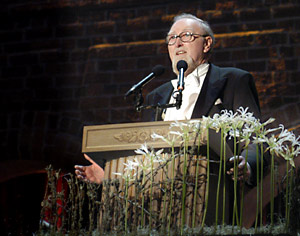Clive W.J. Granger
Banquet speech

Clive W.J. Granger delivering his banquet speech. Copyright © Nobel Media AB 2003
Photo: Hans Mehlin
Clive W.J. Granger’s speech at the Nobel Banquet, December 10, 2003
Rob Engle and I are concerned with extracting useful implications from economic data, and so the properties of the data are of particular importance. Rob deals with financial markets which produce a virtually continuous stream of high quality data. He has available many time series which are strings of numbers plotted out through time.
I work with the macro economy, which involves the major variables that measure the health of the whole economy, such as total consumption, investment, income, employment, and inflation. These variables are measured monthly, or possibly quarterly (or even annually for a few countries).
The stock market is like a small row boat on a rough sea, bouncing around as it drifts, whereas the macro economy is like a large ocean liner, very ponderous and difficult to maneuver but without such a rough journey.
Because our data has different properties, Rob Engle and I developed different techniques to study our data, although there were some common foundations. Rob was concerned with quantifying the concept of risk in financial data and developed a very successful way of doing that, which he denoted ARCH. This measures the size of the waves or the bounce in stock market prices. I was more concerned with building models that central bankers could use for policy purposes and particularly for long run forecasting. The idea is called “cointegration” and provides ways to discover that two large boats are drifting with the same current or that two macroeconomies are moving together. You will find both of these words defined in the Oxford English Dictionary in a few years time!
Forecasts vary in horizon, from a few seconds up to a few days in financial markets, compared to from one to several months for macro variables. We have to provide uncertainty intervals around the central forecasts to indicate the extent to which we are unclear about the future. The ARCH models are concerned with variations in the confidence intervals at different horizons while my methods are concerned with coordination of forecasts for several variables.
The advantage that I have is that it may take a year or more to show that my forecasts were wrong, whereas Rob’s could be found incorrect in about a day! Economists have a bad reputation for forecasting, but by using ARCH and Cointegration we can put forecasts and our confidence in their accuracy on a more scientific basis. These methods are now widely in place in business, government and academic research, and we thank the Nobel committee for its confidence in our forecasts.
Thank you.
Copyright © The Nobel Foundation 2003